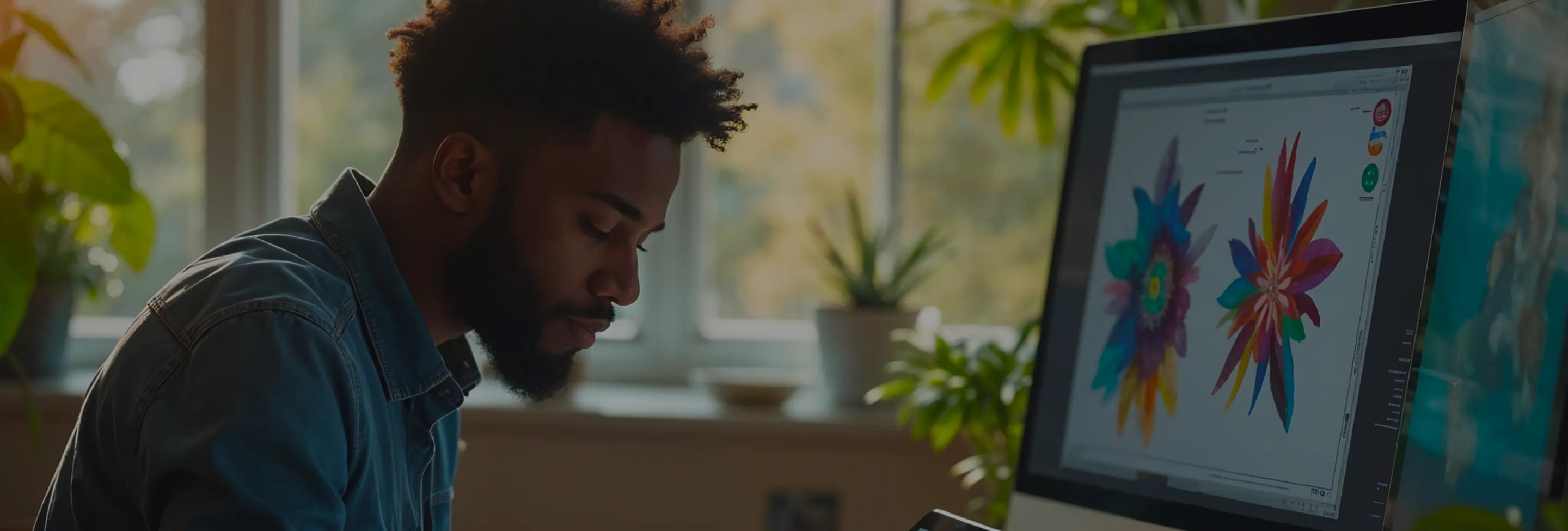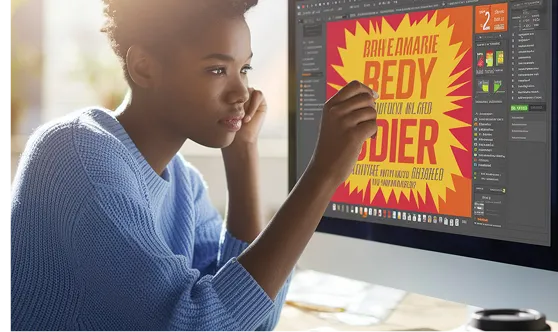
Our analysis of over 2,000 AI-driven design projects revealed the top 20 questions that designers face when integrating artificial intelligence into their workflows. These questions span from foundational concepts to advanced techniques, addressing the most common challenges and misunderstandings. By exploring these critical inquiries, designers can harness AI's full potential to enhance creativity, streamline processes, and achieve outstanding visual results.
AI graphic design leverages artificial intelligence tools and algorithms to assist in creating visual content. Unlike traditional graphic design, which relies solely on human creativity and manual techniques, AI graphic design incorporates machine learning models that can generate, suggest, and optimize design elements based on data patterns and user inputs.
Real-World Example: Tools like Adobe Sensei use AI to automate repetitive tasks such as image tagging and layout adjustments, allowing designers to focus more on creative aspects.
Common Misconception: AI replaces designers. In reality, AI serves as a powerful assistant that enhances a designer's capabilities rather than replacing the creative process.
Actionable Solution: Start by integrating AI tools that handle mundane tasks, freeing up time for more complex and creative work.
Several AI-powered tools have become staples in the graphic design industry:
Configuration Sample: To start with Canva's AI features, sign up for a Canva Pro account and explore the "Magic Resize" tool, which automatically adjusts your design to different dimensions.
Important Note: Each tool has unique strengths; selecting the right one depends on your specific design needs and workflow.
AI enhances efficiency by automating repetitive tasks, offering intelligent suggestions, and enabling rapid prototyping. This allows designers to:
Practical Example: Using AI-powered auto-layout features can quickly generate balanced designs, which can then be fine-tuned manually.
Troubleshooting Tip: If AI suggestions aren't aligning with your vision, adjust the input parameters or combine AI-generated elements with your custom designs for better results.
Machine Learning (ML) algorithms analyze user behavior, preferences, and interactions to create personalized design experiences. By learning from data, ML can tailor design elements to individual tastes, resulting in more engaging and effective visuals.
Real-World Example: E-commerce platforms use ML to customize product images and layouts based on browsing history, enhancing user engagement and conversion rates.
Actionable Solution: Incorporate ML-powered analytics tools to gather user data and inform design decisions that cater to specific audience segments.
Generative Adversarial Networks (GANs) are a class of AI models consisting of two neural networks—the generator and the discriminator—that work together to create realistic images. In graphic design, GANs can generate unique visual elements, such as textures, patterns, and even entire illustrations, by learning from a dataset of existing designs.
Code Example:
import tensorflow as tf
from tensorflow.keras import layers
# Define the generator
def build_generator():
model = tf.keras.Sequential()
model.add(layers.Dense(256, input_dim=100, activation='relu'))
model.add(layers.BatchNormalization())
model.add(layers.Dense(512, activation='relu'))
model.add(layers.BatchNormalization())
model.add(layers.Dense(1024, activation='relu'))
model.add(layers.Dense(28 * 28 * 1, activation='tanh'))
return model
# Define the discriminator
def build_discriminator():
model = tf.keras.Sequential()
model.add(layers.Dense(1024, input_dim=28 * 28 * 1, activation='relu'))
model.add(layers.Dense(512, activation='relu'))
model.add(layers.Dense(256, activation='relu'))
model.add(layers.Dense(1, activation='sigmoid'))
return model
Configuration Sample: Train GANs with a dataset of your own designs to generate new patterns that align with your brand aesthetic.
Edge Case: GANs may produce artifacts or unrealistic elements if not properly trained. Ensure a diverse and comprehensive dataset to improve output quality.
AI can analyze color theory principles and user preferences to generate harmonious color schemes. It can also optimize color palettes for accessibility, ensuring that designs are visually appealing and inclusive.
Practical Example: Tools like Adobe Color use AI to suggest complementary colors based on current design trends and user inputs.
Actionable Solution: Utilize AI-powered color tools to experiment with different palettes and receive real-time feedback on color harmony and contrast.
Troubleshooting Tip: Provide training sessions for your team and establish guidelines for using AI tools to maintain design consistency and quality.
Steps to Resolve:
Important Note: AI is a tool to augment creativity. Combining AI capabilities with human oversight often yields the best outcomes.
Actionable Solution: Establish ethical guidelines for AI use in your design practice and regularly audit AI-generated content for compliance.
AI can introduce unexpected patterns, color combinations, and design elements that spark new ideas. By providing alternative perspectives, AI serves as a creative partner that can push the boundaries of traditional design thinking.
Practical Example: Using AI-generated mood boards can help designers visualize different themes and styles, inspiring unique project directions.
Actionable Solution: Incorporate AI brainstorming sessions where you use generative tools to explore various design possibilities before narrowing down to specific concepts.
Yes, AI can streamline the iterative process by quickly producing multiple design variations based on initial concepts. This enables designers to experiment with different styles, layouts, and elements efficiently, facilitating faster refinement and decision-making.
Real-World Example: Tools like Figma's AI plugins can generate alternative layouts or style adjustments, allowing for rapid prototyping and testing.
Configuration Sample: Set up Figma with AI plugins that automatically suggest layout tweaks as you modify your design elements.
Important Note: While AI accelerates iterations, maintaining a clear vision and critical evaluation of each variation remains essential.
Actionable Solution: Stay informed about AI advancements by following industry news and participating in workshops to integrate upcoming technologies into your design practice proactively.
AI enhances UI/UX design by providing data-driven insights into user behavior, enabling personalized experiences, and automating usability testing. AI can predict user needs, adapt interfaces dynamically, and streamline the design process for more intuitive and engaging applications.
Practical Example: AI-powered heatmaps analyze user interactions on a website, helping designers optimize layout and navigation for better user engagement.
Actionable Solution: Implement AI analytics tools to gather and analyze user interaction data, informing design decisions that enhance overall user experience.
To maintain a unique creative voice while leveraging AI:
Actionable Solution: Establish a workflow where AI handles specific tasks, allowing you to focus on infusing your unique creativity into the final design.
Important Note: Investing in training and professional development can significantly enhance your ability to leverage AI in your design work.
Evaluation Criteria:
Actionable Solution: Develop a checklist based on these criteria to systematically assess AI-generated designs and ensure they meet your quality standards.
AI assists in creating responsive and adaptive designs by automatically adjusting layouts, images, and elements based on different screen sizes and devices. It can predict optimal configurations and streamline the adaptation process, ensuring consistent user experiences across various platforms.
Practical Example: AI tools can analyze user device data to adjust font sizes, image resolutions, and layout structures dynamically, enhancing usability on mobile and desktop devices alike.
Actionable Solution: Integrate AI-powered responsive design tools into your workflow to simplify the creation of versatile and device-agnostic designs.
AI improves accessibility by ensuring designs are inclusive and meet accessibility standards. It can analyze color contrasts, suggest alternative text for images, and identify design elements that may hinder usability for individuals with disabilities.
Real-World Example: Tools like Stark integrate with design software to automatically check for color contrast issues and simulate how designs appear to users with color blindness.
Actionable Solution: Use AI accessibility tools to scan and refine your designs, making them more inclusive and compliant with accessibility guidelines.
Yes, AI can automate the creation of various marketing materials such as social media graphics, email templates, and advertisements. By generating templates and suggesting content variations, AI streamlines the production process, allowing for quick adaptations to different marketing campaigns.
Practical Example: Platforms like Crello use AI to generate customized social media posts based on the latest trends and user preferences.
Actionable Solution: Leverage AI-powered marketing design tools to produce consistent and high-quality materials efficiently, freeing up time for strategic planning and creative initiatives.
Limitations:
Overcoming Strategies:
Actionable Solution: Use AI as a complementary tool, enhancing your design capabilities while relying on human creativity and critical thinking to address its limitations.
By addressing these critical questions, graphic designers can navigate the evolving landscape of AI integration with confidence and expertise. Embracing AI's capabilities while recognizing its boundaries enables designers to innovate, streamline their workflows, and produce visually compelling work that stands out in a competitive market.




Subscribe to our newsletter to receive $100 off your first month of Tapflare's flat rate unlimited design and development service. Your coupon code will be sent to your email.